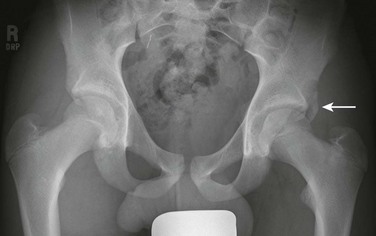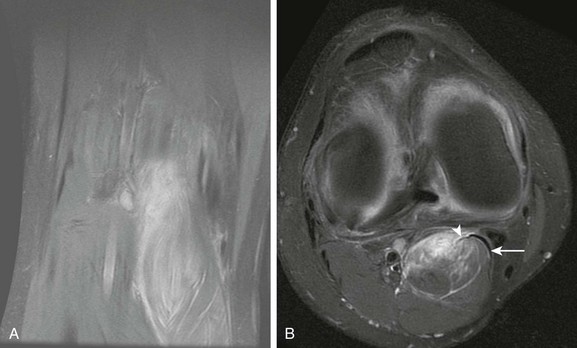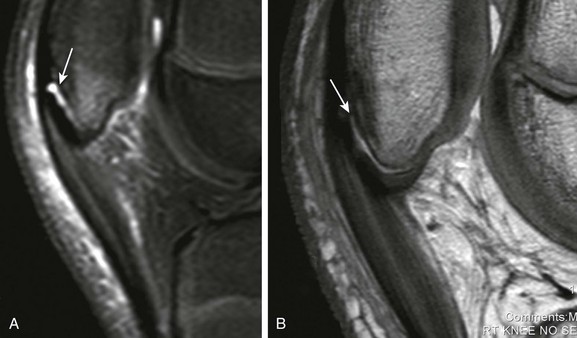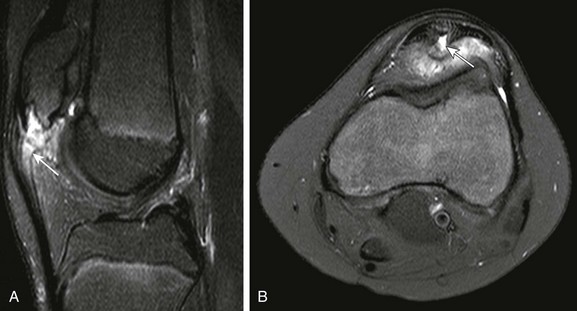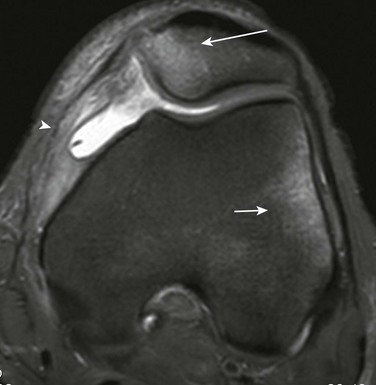Sports Medicine
In the United States, greater than 30 million (approximately one third) of school-aged children participate in organized sports.1 Sports-related injuries occur more frequently in the lower extremities compared with the upper extremities. This section will review acute and chronic sports injury patterns with an emphasis on entities that are unique in children. This section will cover multimodality imaging and emphasize important magnetic resonance imaging (MRI) features related to pediatric sports injuries. Acute fractures and dislocations are covered in Chapter 143.
Avulsion Injuries and Muscle Injuries
Etiology: Avulsion injuries or fractures may occur at muscle attachments to an apophysis or at ligamentous attachments to a chondro-osseous junction.
The musculoskeletal unit of the child is composed of the apophysis, tendon, myotendinous junction, and muscle belly. In the skeletally mature patient, the weakest component of the musculoskeletal unit is the myotendinous junction. In the skeletally immature patient, particularly during periods of rapid growth, the cartilaginous physeal equivalent region of the apophysis is the weakest component of the musculoskeletal unit.2 As a consequence, apophyseal avulsion injuries (Fig. 145-1), rather than myotendinous tears, may occur when the musculoskeletal unit is stressed.
Apophyseal injuries are more frequent in the lower extremity than in the upper extremity. In the lower extremity, the pelvis and knee are the most common sites for apophyseal avulsion injuries.3 Ligamentous avulsion injuries similarly are more common in the lower extremity than in the upper extremity.
After the apophysis, the next weakest component of the musculoskeletal unit is the myotendinous junction. Muscle tears most commonly occur at the myotendinous junctions. Myotendinous tears are an acute event during a physical activity in which a child can pinpoint the time (within seconds) in which the injury occurred. This should be differentiated from delayed onset muscle soreness (DOMS). DOMS is not related to a single event but may be caused by an activity with repetitive eccentric and concentric muscle contractions with no acute pain at the time of the activity. Instead, symptoms and pain usually are felt the following day after the activity.4
Imaging: In the acute setting, the displaced avulsion fracture fragment is present without proliferative callus formation present (see Fig. 145-1). During healing, proliferative callus will be seen, suggesting its subacute or chronic nature.
When radiographs are negative and no displaced fragment exists, an MRI scan may be obtained. MRI may demonstrate subtle edema of the apophysis and metaphyseal equivalent bone, physeal equivalent edema and widening, and adjacent soft tissue edema (e-Fig. 145-2). The term fracture should be used only when a linear displaced or nondisplaced fracture is present. When edema alone is present within the apophysis and adjacent soft tissues, the term avulsion injury should be used.
MRI may also demonstrate avulsion injuries and fractures at the level of the chondro-osseous junction (Fig. 145-3).
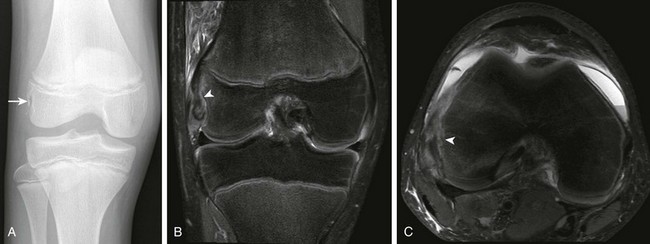
Figure 145-3 A 13-year-old boy with a popliteus origin chondro-osseous avulsion fracture (arrow).
A, An anteroposterior knee radiograph. B, Proton density fat-saturated coronal image. C, Proton density fat suppression axial image demonstrates chondro-osseous fracture line (arrowhead).
MRI is preferred for delineating the remainder of the musculoskeletal unit. When muscle edema is present related to trauma, three possible etiologies exist: (1) DOMS (Fig. 145-4), (2) direct muscle contusion (e-Fig. 145-5), and (3) myotendinous muscle tear (Fig. 145-6) (Table 145-1). With DOMS, MRI shows diffuse edema on fluid sensitive sequences without discrete fiber disruption. Direct muscle contusions shows similar changes to DOMS but are more focal in nature when injury is mild, with discrete fiber disruption and hematoma formation when the injury is severe. In the setting of muscle hematomas, these may mimic an intramuscular abscess. Gadolinium-enhanced, T1-weighted, fat-saturated imaging may demonstrate rim enhancement for both hematomas and intramuscular abscess. T1-weighted imaging without gadolinium may demonstrate T1-weighted hyperintense foci related to blood products and may suggest muscle hematoma and less likely intramuscular abscess with proteinaceous content. Myotendinous muscle tears may range from partial, with only some fibers disrupted at the level of the aponeurosis, to complete disruption with muscle fiber and aponeurosis retraction.
Table 145-1
Magnetic Resonance Imaging Appearance and Grading of Myotendinous Tears
| Grade 1 | Edema at the myotendinous junction |
| Grade 2 | Partial tearing at the myotendinous junction |
| Grade 3 | Complete tear at the myotendinous junction with tendon retraction |
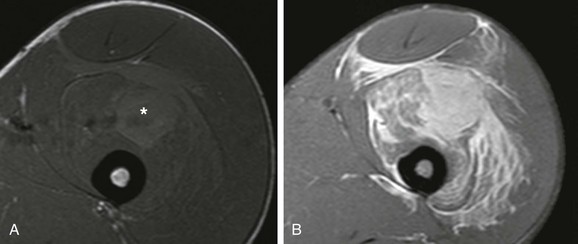
e-Figure 145-5 A 17-year-old boy with vastus intermedius direct muscle contusion.
A, A T1-weighted axial image demonstrates hyperintense material, consistent with blood products, located in the vastus intermedius muscle belly (asterisk). B, A T2-weighted fat suppression axial image demonstrates fiber muscle disruption and extensive infiltrative myositis and tearing of the vastus intermedius muscle fibers and deep fascial edema.
Treatment and Follow-up: Treatment varies, depending on the location of the apophyseal avulsion injury. In the pelvis, the majority of apophyseal avulsion injuries are treated conservatively with rest. Surgical reduction and fixation may be necessary when the avulsed fracture fragment is greater than 2 cm.3 During the healing phase, radiographs may be helpful to monitor callus formation and healing. Apophyseal avulsion fractures elsewhere are usually treated conservatively, and surgical reduction is based on degree of apophyseal displacement. For instance, medial epicondylar avulsion fractures are treated surgically when the displaced fragment is greater than 5 mm.5
Myotendinous tears are treated conservatively with 2 to 3 weeks of rest before returning to sport activities.4 DOMS is also treated conservatively and symptoms usually resolve within a week.
Hyperextension Injuries of the Knee
Etiology: The anterior compartment of the knee is composed of the quadriceps tendon, patellar bone, patella tendon, and tibial tuberosity. Patellar bone is a sesamoid equivalent for the quadriceps mechanism. Acute forceful concentric or eccentric contraction of the quadriceps muscle may lead to acute avulsion injuries of the inferior patellar pole (chondro-osseous avulsion injury, patellar sleeve fractures) and tibial tuberosity (apophyseal avulsion injury), as well as tendinopathy of the patella tendon. Sinding-Larsen-Johansson disease is the term used for chronic avulsive injuries affecting the inferior patellar pole. Osgood-Schlatter disease is the equivalent injury affecting the tibial tuberosity.1 When only a patella tendon tear is present, it is called jumper’s knee and tends to occur in patients who are skeletally mature. Sinding-Larsen-Johansson and Osgood-Schlatter diseases usually occur during adolescence and often affect both knees. Bone and tendon injuries often may occur in the same knee.
Imaging: Although imaging is helpful for the diagnosis of Sinding-Larsen-Johansson and Osgood-Schlatter diseases, the diagnosis for these chronic conditions is made clinically with radiographic confirmation of findings, not by imaging alone. Advanced imaging confirms the diagnosis and excludes alternative etiologies. MRI should not be performed routinely on these patients if radiography and clinical diagnosis confirm the disease.
Patellar sleeve fractures represent an acute avulsion fracture located along the inferior pole of the patella. This occurs at the chondro-osseous junction of the patella tendon origin. On radiography and MRI, a small linear or curvilinear fleck of bone may be identified (Fig. 145-7). On MRI, edema of the patellar bone, edema in the superior aspect of Hoffa’s fat pad, and peripatellar edema are often present in the acute setting. This should be differentiated from chronic repetitive avulsive injuries to the inferior patellar pole leading to Sinding-Larsen-Johansson disease. With Sinding-Larsen-Johansson disease, the inferior patellar bone has had time to remodel related to chronic avulsive injury. Therefore, on radiography and MRI, well-formed variable size ossicles may be seen (Fig. 145-8). On MRI, edema within the inferior pole ossicles is related to the acute or chronic nature of the injury.
Acute tibial tuberosity avulsion fractures results from forceful contraction of the patella tendon leading to a tibial tuberosity–sided linear or curvilinear avulsion fracture fragment at the level of the chondro-osseous junction (Fig. 145-9) or to uplifting of the entirety of the tibial tuberosity, with resultant Salter-Harris type injury with physeal equivalent widening (Fig. 145-10). On MRI, often, edema is seen within the tibial tuberosity, and this may extend posteriorly to involve the remainder of the tibial epiphysis. Inferior Hoffa’s fat pad and pretibial edema are often present. These changes should be differentiated from chronic repetitive avulsive injury affecting the tibial tuberosity and leading to Osgood-Schlatter disease. With Osgood-Schlatter disease, rather than linear avulsion fracture fragments, the tibial tuberosity and tibial tuberosity avulsion fragments have had time to remodel. Therefore, on radiography and MRI, well-formed variable size well-corticated ossicles may be seen (e-Fig. 145-11). On MRI, edema within the avulsed separate ossicles and tibial tuberosity are present and are related to the acute or chronic nature of the injury. In addition, edema within Hoffa’s fat pad and pretibial edema are often present as well.
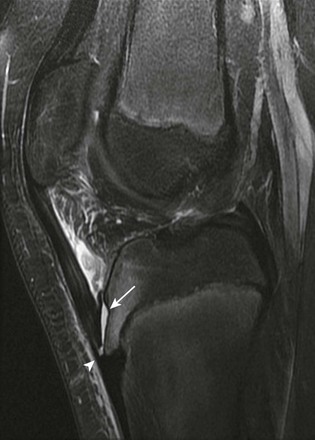
Figure 145-9 A T2-weighted fat suppression sagittal image from a 13-year-old boy demonstrates an acute nondisplaced partial tibial tuberosity avulsion fracture (arrow).
Note that some patella tendon fibers remain intact (arrowhead).

Figure 145-10 A 14-year-old girl with tibial tuberosity equivalent physeal widening.
A, A T2-weighted fat suppression sagittal image demonstrates diffuse edema of the tibial tuberosity, physis, and deep metaphyseal equivalent region of the tibia. B, A proton density sagittal image delineates physeal equivalent widening of the tibial tuberosity (arrow). Note the physeal equivalent widening compared with the normal posteriorly located tibial physis (arrowhead).

e-Figure 145-11 A 15-year-old with Osgood-Schlatter disease.
A, Lateral radiograph. B, Proton density sagittal image of the knee demonstrates tibial tuberosity fragmentation. C, A T2-weighted fat suppression sagittal image demonstrates edema of the tibial fragmentation (arrow) and adjacent Hoffa’s fat pad.
Patella tendinopathy and patellar tears (e-Fig. 145-12) may be evaluated by ultrasonography or MRI. On MRI, thickening of the tendon with longitudinally or transversely oriented tears may be seen as well as edema within the prepatellar soft tissues and Hoffa’s fat pad. MRI diagnosis of jumper’s knee should ideally be made on longer echo time sequences to avoid “magic angle artifact.”
Treatment and Follow-up: Sinding-Larsen-Johansson disease, Osgood-Schlatter disease, and jumper’s knee are all treated conservatively with rest. When displaced, acute avulsion fractures of the inferior patellar pole or tibial tuberosity may be treated by open reduction with patellar tendon reconstruction, particularly if patella alta is also present.6 For avulsion fractures, care should be made to determine if the fracture is complete, incomplete, displaced, or nondisplaced. If the avulsion fracture is incomplete (see Fig. 145-9), affected children may benefit from conservative nonsurgical treatment.
Patellar Dislocation and Patellofemoral Dysplasia
Etiology: The patella is a sesamoid equivalent bone of the quadriceps mechanism. Patellar bone has two primary facets: medial and lateral. The lateral facet is usually the dominant and larger facet, and articulates with the lateral aspect of the trochlear fossa. Patellar bone lies within the concave shaped femoral trochlear fossa. With knee flexion, the patella will concentrically locate within the trochlear fossa. With knee extension, patellar bone preferentially subluxes laterally in patients with or without underlying patellofemoral dysplasia because the lateral patellofemoral articulation is shallow compared with the medial articulation and the vastus lateralis activates when the knee is extended.
Multiple variables may predispose a patient to patellar dislocation. This includes a large Q-angle, muscle imbalance with dominant vastus lateralis musculature, patella alta, rotational abnormalities of the tibia and femur, and overall ligamentous laxity. The Q-angle is calculated by the angle derived from the intersection of two lines: (1) center of patella and anterosuperior iliac spine and (2) center of patella and tibial tuberosity. The normal Q-angle measures approximately 15 degrees. The Q-angle is usually larger in females. Larger Q-angles direct the quadriceps muscle vector force on the patella laterally. Patella alta occurs when the ratio of patellar tendon length to patellar bone length is greater than 1 : 2. Patellar bone captures within the trochlear groove with knee flexion. In the setting of patella alta, it takes relatively more knee flexion for the patellar bone to capture. Excessive external tibial torsion may also predispose a child to patellar dislocation, as well as increased femoral anteversion.7,8 The normal degree of external tibial torsion is approximately 28 degrees at age 4 years and increases to approximately 38 degrees at skeletal maturity.9 The normal degree of femoral anteversion is approximately 40 degrees at birth and approximately 15 degrees at skeletal maturity.
Imaging: Radiographs should be reviewed to identify loose bodies, subjective determination of patella alta, and patellofemoral dysplasia. The “sunrise view” is helpful to evaluate for patellar sleeve fractures for both acute (Fig. 145-13) and old injuries (e-Fig. 145-14). Acute patellar sleeve fractures are sliverlike, whereas old injuries are round and corticated. These patellar sleeve fractures occur along the medial pole and are a result of avulsion injury at the medial retinacular attachment to the chondro-osseous junction of the medial patellar pole. The sunrise view is also useful for evaluating for patellofemoral dysplasia. Features suggesting patellofemoral dysplasia include a lateral dominant patellar facet and a flat or even convex appearing trochlear fossa. With progressive patellofemoral dysplasia, the trochlear fossa becomes more convex in appearance and the patellar bone loses its normal angular appearance.

Figure 145-13 An 18-year-old with acute patellar dislocation, with acute, medial patellar sleeve fracture (arrow).
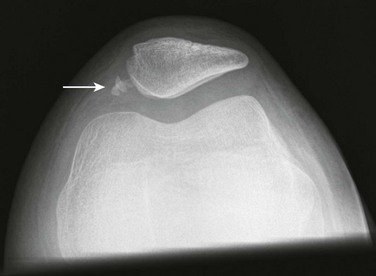
e-Figure 145-14 An 11-year-old girl with old, medial patellar sleeve fracture (arrow) caused by prior patellar dislocation.
These fracture fragments are corticated (indicative that they are old) in contrast to acute fracture fragments that are not yet corticated (see Fig. 145-13).
Computed tomography (CT) may be obtained in the workup of patellofemoral dysplasia. CT may be used to determine tibial and femoral version. As external tibial torsion and femoral anteversion increases, the child is at higher risk for patellar instability and tilt.7,8 CT may also be performed with the knees at various degrees of flexion (e-Fig. 145-15). The patella locates with increasing knee flexion and subluxes with increasing knee extension. Three separate CT acquisitions are obtained at different degrees of knee flexion (e.g., 45, 30, and 15 degrees). If the patella dislocates at 15 degrees but is located at 45 and 30 degrees, it is considered a mild degree of patellar dislocation. However, if the patella dislocates at 30 or 45 degrees of knee flexion, it is a more severe degree of patellar dislocation. CT for patellar dislocation should also be used to evaluate the degree of patellofemoral dysplasia and secondary patellofemoral osteoarthritis, with changes similar to what may be seen on sunrise-view radiographs. Lateralization of the tibial tuberosity should also be determined. This represents the distance between the midpoint of the tibial tuberosity and the deepest component of the trochlear groove on axial slices. If the tibial tuberosity is greater than 2 cm lateral with respect to the trochlear groove, a higher incidence of patellar instability exists.10
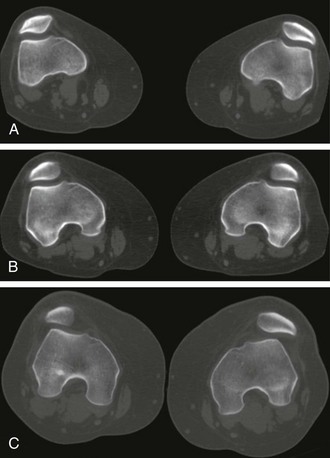
e-Figure 145-15 A dynamic computed tomography scan of bilateral patellofemoral joints at 45 degrees (A), 30 degrees (B), and 15 degrees (C) of knee flexion.
Note with progressive knee extension, the patellar subluxes and tilts laterally, left greater than right.
MRI complements radiography and CT findings. Sometimes, children are referred for knee pain, and the diagnosis of patellar dislocation and patellofemoral dysplasia may be first suspected on MRI. On MRI for acute patellar dislocation, characteristic bone contusions may be seen along the medial patellar pole and anterolateral femoral condyle (Fig. 145-16). The bone contusions occur in relation to relocation of the patella after patellar dislocation. Other findings that may be seen include patellar sleeve fractures, medial retinacular tears, cartilage injuries, and loose bodies. Patellofemoral dysplasia (Fig. 145-17) and secondary degenerative changes should also be assessed by MRI.
Treatment and Follow-up: Treatment for patellar dislocation should be approached from two perspectives: (1) treat biomechanical instability, which can be addressed by physical therapy and operative repair, and (2) treat mechanical symptoms related to sequelae from acute dislocation usually from loose bodies or chondral injuries.

